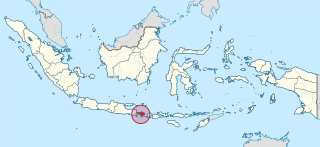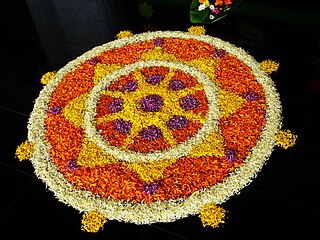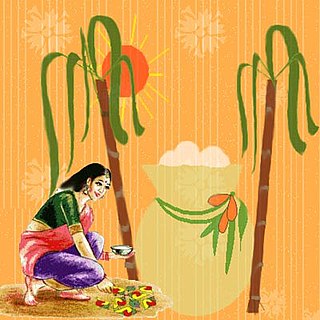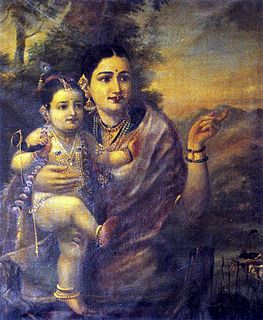
Bali is a province of Indonesia and the westernmost of the Lesser Sunda Islands. East of Java and west of Lombok, the province includes the island of Bali and a few smaller neighbouring islands, notably Nusa Penida, Nusa Lembongan, and Nusa Ceningan. The provincial capital, Denpasar, is the most populous city in the Lesser Sunda Islands and the second-largest, after Makassar, in Eastern Indonesia. The upland town of Ubud in Greater Denpasar is considered Bali's cultural centre. The province is Indonesia's main tourist destination, with a significant rise in tourism since the 1980s. Tourism-related business makes up 80% of its economy.

Puja or pooja is a worship ritual performed by Hindus, Buddhists and Jains to offer devotional homage and prayer to one or more deities, to host and honour a guest, or to spiritually celebrate an event. It may honour or celebrate the presence of special guests, or their memories after they die. The word pūjā is Sanskrit, and means reverence, honour, homage, adoration and worship. Puja, the loving offering of light, flowers, and water or food to the divine, is the essential ritual of Hinduism. For the worshipper, the divine is visible in the image, and the divinity sees the worshipper. The interaction between human and deity, between human and guru, is called darshan, seeing.

Onam is an annual Hindu harvest festival celebrated in the Indian state of Kerala. A major annual event for Keralites, it is the official festival of the state and includes a spectrum of cultural events. Drawing from Hindu legends, Onam commemorates King Mahabali.

Hinduism in Southeast Asia had a profound impact on the region's cultural development and its history. As the Indic scripts were introduced from India, people of Southeast Asia entered the historical period by producing their earliest inscriptions around the 1st to 5th century CE. Today, Hindus in Southeast Asia are mainly Overseas Indians and Balinese. There are also Javanese and Cham minority in Cambodia and southern Vietnam who practices Hinduism.

Pongal, is also referred to as Thai Pongal, is a multi-day Hindu harvest festival of South India, particularly in the Tamil community. It is observed at the start of the month Tai according to Tamil solar calendar, and this is typically about January 14. It is dedicated to the Hindu sun god, the Surya, and corresponds to Makar Sankranti, the harvest festival under many regional names celebrated throughout India. The three days of the Pongal festival are called Bhogi Pongal, Surya Pongal and Maattu Pongal. Some Tamils celebrate a fourth day of Pongal as Kaanum Pongal.

Balinese Hinduism is the form of Hinduism practiced by the majority of the population of Bali. This is particularly associated with the Balinese people residing on the island, and represents a distinct form of Hindu worship incorporating local animism, ancestor worship or Pitru Paksha.

The culture of Indonesia has been shaped by long intermction between original indiges customs and multiple foreign influences. Indonesia is centrally-located along ancient trading routes between the Far East, South Asia and the Middle East, resulting in many cultural practices being strongly influenced by a multitude of religions, including Buddhism, Christianity, Confucianism, Hinduism, and Islam, all strong in the major trading cities. The result is a complex cultural mixture very different from the original indigenous cultures.

The Balinese people are an ethnic group native to the Indonesian island of Bali. The Balinese population of 4.2 million live mostly on the island of Bali, making up 89% of the island's population. There are also significant populations on the island of Lombok and in the easternmost regions of Java.

Maha Shivaratri is a Hindu festival celebrated annually in honour of the god Shiva. The name also refers to the night when Lord Shiva performs the heavenly dance. There is a Shivaratri in every luni-solar month of the Hindu calendar, on the month's 13th night/14th day, but once a year in late winter and before the arrival of Summer, marks Maha Shivaratri which means "the Great Night of Shiva".

Krishna Janmashtami, also known simply as Janmashtami or Gokulashtami, is an annual Hindu festival that celebrates the birth of Krishna, the eighth avatar of Vishnu. According to Hindu lunisolar calendar, it is observed on the eighth tithi (Ashtami) of the Krishna Paksha in Bhadrapada Masa. This overlaps with August or September of the Gregorian calendar.

Pendet dance is a traditional dance from Bali, Indonesia, in which floral offerings are made to purify the temple or theater as a prelude to ceremonies or other dances. Pendet is typically performed by young girls, carrying bowls of flower petals, handfuls of which are cast into the air at various times in the dance. Pendet can be thought of as a dance of greeting, to welcome the audience and invite spirits to enjoy a performance. It is one of the oldest Balinese dance, although the current form was codified in the 1950s.

Gudhi Padwa is a spring-time festival that marks the traditional new year for Marathi and Konkani Hindus, but is also celebrated by other Hindus as well. It is celebrated in and around Maharashtra, Goa, and the union territory of Damaon on the first day of the Chaitra month, to mark the beginning of the new year according to the lunisolar method of the Hindu calendar. Padava or paadvo comes from the Sanskrit word pratipada, which is the first day of a lunar fortnight. The spring festival is observed with colourful floor decorations called rangoli, a special Gudhi dvaja, street processions, dancing& festive foods.

Hinduism in Indonesia, as of the 2018 census, is practised by about 1.74% of the total population, and almost 87% of the population in Bali. Hinduism is one of the six official religions of Indonesia. Hinduism came to Indonesia in the 1st-century through traders, sailors, scholars and priests. A syncretic fusion of pre-existing Javanese folk religion, culture and Hindu ideas, that from the 6th-century also synthesized Buddhist ideas as well, evolved as the Indonesian version of Hinduism. These ideas continued to develop during the Srivijaya and Majapahit empires. About 1400 CE, these kingdoms were introduced to Islam from coast-based Muslim traders, and thereafter Hinduism mostly vanished from many of the islands of Indonesia.

Besakih Temple is a pura complex in the village of Besakih on the slopes of Mount Agung in eastern Bali, Indonesia. It is the most important, the largest and holiest temple of Balinese Hinduism, and one of a series of Balinese temples. Perched nearly 1000 meters up the side of Gunung Agung, it is an extensive complex of 23 separate but related temples with the largest and most important being Pura Penataran Agung. The temple is built on six levels, terraced up the slope. The entrance is marked by a candi bentar, and beyond it the Kori Agung is the gateway to the second courtyard.

Nyepi is a Balinese "Day of Silence" that is commemorated every Isakawarsa according to the Balinese calendar. It is a Hindu celebration mainly celebrated in Bali, Indonesia. Nyepi, a public holiday in Indonesia, is a day of silence, fasting and meditation for the Balinese. The day following Nyepi is also celebrated as New Year's Day. On this day, the youth of Bali in the village of Sesetan in South Bali practice the ceremony of Omed-omedan or 'The Kissing Ritual' to celebrate the new year. The same day is celebrated in India as Ugadi.

Hinduism is a minority religion in Belgium. According to the PEW 2014, Hinduism is also the fastest growing religion in Belgium. Attempts have been done by the Hindu Forum of Belgium (HFB) to make Hinduism an officially-recognized religion in Belgium.

Balinese dance is an ancient dance tradition that is part of the religious and artistic expression among the Balinese people of Bali island, Indonesia. Balinese dance is dynamic, angular and intensely expressive. Balinese dancers express the stories of dance-drama through the bodily gestures including gestures of fingers, hands, head and eyes.

Dance in Indonesia reflects the country's diversity of ethnicities and cultures. There are more than 1,300 ethnic groups in Indonesia. Austronesian roots and Melanesian tribal forms are visible, and influences ranging from neighboring Asian and even western styles through colonization. Each ethnic group has its own dances: there are more than 3,000 original dance forms in Indonesia. The old traditions of dance and drama are being preserved in the many dance schools which flourish not only in the courts but also in the modern, government-run or supervised art academies.

Batuan is a village in Bali, Indonesia. It is noted for its artwork and style of painting which originated in the village in the 1930s and has since emerged into a major Balinese artistic style, known as a Batuan painting. It is a major painting center and contains a number of art galleries and cooperative art societies which have played a key role in promoting the art of Batuan. The village is also known for its performance of the ancient Gambuh dance, performed every Full Moon day.

A wantilan is a Balinese pavilion (bale) used for activities involving large crowds. A wantilan is the largest type of bale in Balinese architecture. A wantilan is basically a large wall-less hall placed under a large multi-tiered roof. A wantilan as a public building is usually located at a village's main square or main junction and functions as an open hall to hold large community activities such as meeting halls or a public musical gamelan performance. A wantilan is also a religious building, an integral part of Balinese temples used to hold the Balinese cockfighting ceremony.




















